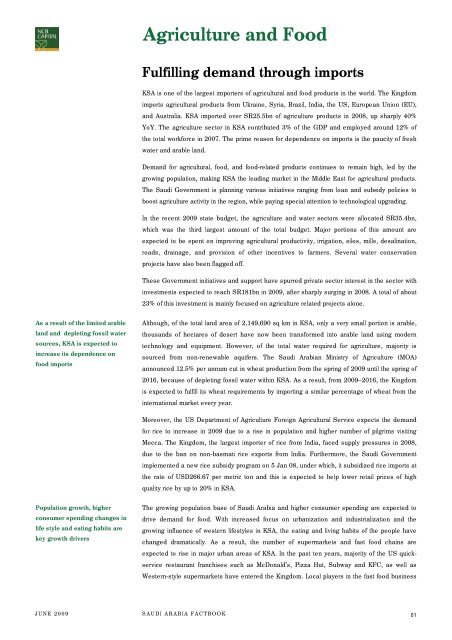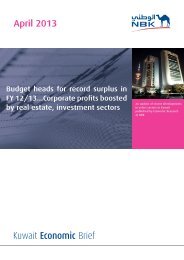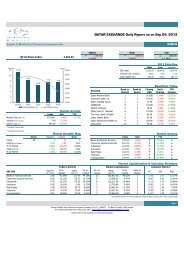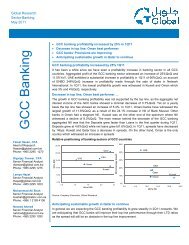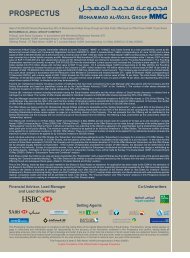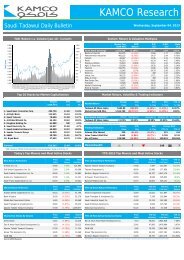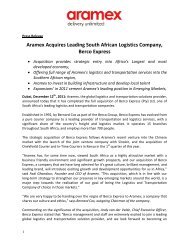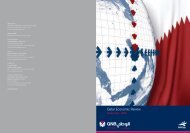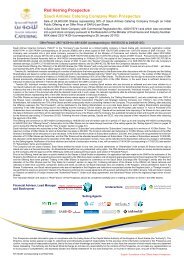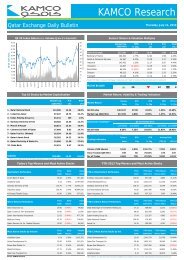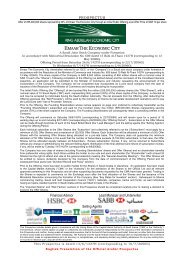to download the complete report - GulfBase.com
to download the complete report - GulfBase.com
to download the complete report - GulfBase.com
Create successful ePaper yourself
Turn your PDF publications into a flip-book with our unique Google optimized e-Paper software.
Agriculture and FoodFulfilling demand through importsKSA is one of <strong>the</strong> largest importers of agricultural and food products in <strong>the</strong> world. The Kingdomimports agricultural products from Ukraine, Syria, Brazil, India, <strong>the</strong> US, European Union (EU),and Australia. KSA imported over SR25.5bn of agriculture products in 2008, up sharply 40%YoY. The agriculture sec<strong>to</strong>r in KSA contributed 3% of <strong>the</strong> GDP and employed around 12% of<strong>the</strong> <strong>to</strong>tal workforce in 2007. The prime reason for dependence on imports is <strong>the</strong> paucity of freshwater and arable land.Demand for agricultural, food, and food-related products continues <strong>to</strong> remain high, led by <strong>the</strong>growing population, making KSA <strong>the</strong> leading market in <strong>the</strong> Middle East for agricultural products.The Saudi Government is planning various initiatives ranging from loan and subsidy policies <strong>to</strong>boost agriculture activity in <strong>the</strong> region, while paying special attention <strong>to</strong> technological upgrading.In <strong>the</strong> recent 2009 state budget, <strong>the</strong> agriculture and water sec<strong>to</strong>rs were allocated SR35.4bn,which was <strong>the</strong> third largest amount of <strong>the</strong> <strong>to</strong>tal budget. Major portions of this amount areexpected <strong>to</strong> be spent on improving agricultural productivity, irrigation, silos, mills, desalination,roads, drainage, and provision of o<strong>the</strong>r incentives <strong>to</strong> farmers. Several water conservationprojects have also been flagged off.These Government initiatives and support have spurred private sec<strong>to</strong>r interest in <strong>the</strong> sec<strong>to</strong>r withinvestments expected <strong>to</strong> reach SR181bn in 2009, after sharply surging in 2008. A <strong>to</strong>tal of about23% of this investment is mainly focused on agriculture related projects alone.As a result of <strong>the</strong> limited arableland and depleting fossil watersources, KSA is expected <strong>to</strong>increase its dependence onfood importsAlthough, of <strong>the</strong> <strong>to</strong>tal land area of 2,149,690 sq km in KSA, only a very small portion is arable,thousands of hectares of desert have now been transformed in<strong>to</strong> arable land using moderntechnology and equipment. However, of <strong>the</strong> <strong>to</strong>tal water required for agriculture, majority issourced from non-renewable aquifers. The Saudi Arabian Ministry of Agriculture (MOA)announced 12.5% per annum cut in wheat production from <strong>the</strong> spring of 2009 until <strong>the</strong> spring of2016, because of depleting fossil water within KSA. As a result, from 2009–2016, <strong>the</strong> Kingdomis expected <strong>to</strong> fulfill its wheat requirements by importing a similar percentage of wheat from <strong>the</strong>international market every year.Moreover, <strong>the</strong> US Department of Agriculture Foreign Agricultural Service expects <strong>the</strong> demandfor rice <strong>to</strong> increase in 2009 due <strong>to</strong> a rise in population and higher number of pilgrims visitingMecca. The Kingdom, <strong>the</strong> largest importer of rice from India, faced supply pressures in 2008,due <strong>to</strong> <strong>the</strong> ban on non-basmati rice exports from India. Fur<strong>the</strong>rmore, <strong>the</strong> Saudi Governmentimplemented a new rice subsidy program on 5 Jan 08, under which, it subsidized rice imports at<strong>the</strong> rate of USD266.67 per metric <strong>to</strong>n and this is expected <strong>to</strong> help lower retail prices of highquality rice by up <strong>to</strong> 20% in KSA.Population growth, higherconsumer spending changes inlife style and eating habits arekey growth driversThe growing population base of Saudi Arabia and higher consumer spending are expected <strong>to</strong>drive demand for food. With increased focus on urbanization and industrialization and <strong>the</strong>growing influence of western lifestyles in KSA, <strong>the</strong> eating and living habits of <strong>the</strong> people havechanged dramatically. As a result, <strong>the</strong> number of supermarkets and fast food chains areexpected <strong>to</strong> rise in major urban areas of KSA. In <strong>the</strong> past ten years, majority of <strong>the</strong> US quickservicerestaurant franchises such as McDonald’s, Pizza Hut, Subway and KFC, as well asWestern-style supermarkets have entered <strong>the</strong> Kingdom. Local players in <strong>the</strong> fast food businessJUNE 2009SAUDI ARABIA FACTBOOK61


